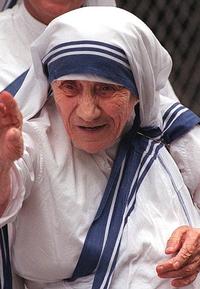Shoqata e Shkrimtarėve Shqiptaro-Amerikanė: NĖNĖ TEREZA KA KOMBĖSI SHQIPTARE-- Letėr drejtuar redaktorit tė gazetėt "The New York Times"
Shoqata e Shkrimtarėve Shqiptaro-Amerikanė ka konsideratė tė lartė pėr gazetėn prestigjioze New York Times, prandaj i vjen keq kur botohen nė faqet e saj artikuj dizinformues ose qė shtrėmbėrojnė tė vėrtetėn. I tillė qe artikulli i z. Ian Fisher botuar mė datė 6 gusht 2003, faqe 6, ku autori e mohon kombėsine shqiptare tė Nėnė Terezės, me argumente pa baza historike a shkencore. Ja argumentet kryesore qė paraqet zoti Fisher pėr tė mbrojtur tezėn e tij: 1. Nėnė Tereza nuk ka si tė jetė shqiptare a me kombėsi shqiptare, kur dihet se ishte katolike e ritit Latin, ndėrsa shqiptarėt janė myslimanė. Ēdo njeri qė ka sado pak dijeni mbi shqiptarėt, e di se ata u pėrkasin tre besimeve fetare myslimanė, ortodoksė tė ritit Bizantin dhe katolikė tė ritit Roman, pa llogaritur sektin Bektashi. E njėjta pėrbėrje fetare zotėron edhe nė trevat e banuara nga shqiptarėt, si nė Kosovė, Maqedoni dhe Mal tė Zi. Nė Maqedoni gjithmonė ka patur ortodoksė dhe katolikė shqiptarė, ashtu sikurse ka edhe sot. Dijetarėt dhe etnografėt e huaj kanė shfaqur admirim pėr tolerancėn fetare ndėrmjet shqiptarėve qė vazhdon prej shekujsh. Ndofta nė asnjė vend tė botės nuk ka aq martesa mikste sa te shqiptarėt, nė raport me popullsinė. 2. Mbiemri vajzėror i Nėnė Terezės, Gonxhe Bojaxhiu hedh dyshime mbi kombėsinė e saj, mbasi gjuha shqipe nuk ka mbaresa u pėr mbiemrat. Ky argument filologjik dėshmon se autori ka mangėsi nė fushėn e onomastikės shqipe. Edhe librin e telefonave sikur tė kishte shfletuar, do tė kishte gjetur njė tok mbiemrash me mbaresėn u. Shumica e mbiemrave tė shqiptarėve, me prejardhje nga profesionet, mbarojnė me u. Shembuj: Bojaxhiu, (painter); Kundraxhiu, (shoemaker); Terziu, (taylor); Furrxhiu (bakery); Djepaxhiu, (cradlemaker); Sapunxhiu, (soapmaker); Hanxhiu, (The owner of an Inn); etj. 3. Nėnė Tereza nuk dinte shqip dhe nuk fliste shqip. Nėnė Tereza haste vėshtirėsi pėr tė folur rrjedhshėm shqip, pas njė emigrimi prej 7 dekadash, por ajo kurrė nuk e ka mohuar origjinėn e saj shqiptare. Kur ishte e re jo vetėm ka folur, por ka shkrojtur edhe poezi nė gjuhėn shqipe. A mund tė shkruante shqip po tė mos ishte shqiptare? Nė kohėn qė shkruajti poezinė, tė cilėn po ua servirim shqip e anglisht, ajo ishte 22 vjeēe. Besojmė se kjo dėshmi e patjetėrsueshme, mjafton pėr tė bindur edhe mė skeptikėt pėr kombėsinė e saj shqiptare.
Pėr Shoqatėn e Shkrimtarėve Shqiptaro-Amerikanė
GOODBYE
I am leaving the glowing hearth,
I bid goodbye to fretful friends,
Goodbye, dear mother,
The boat sails ever so lightly,
An iron cross she clasps in her hand,
Accept, oh, Lord, this sacrifice,
In return, oh, Gracious Lord,
Pure as a summer drizzle at dawn,
Translated from Albanian by Peter R. Prifti ALBANIAN CATHOLIC BULLETIN, San Francisco, CA., Vol. XII, 1991
LAMTUMIRĖ
Po lė shtėpinė zemėrfanar
Lė tė njohurit nė mejtime
Nėnė e dashur, lamtumirė
Dhe anija lehtė lehtė lundron
Qėndron nė anije e galduar
Njė kryq hekuri ndorė shtėrngon
Pranoje, kėtė flijim, o Zot,
Si shpėrblim, Tė lus o i Hirt,
Dhe timtė, tė pastėr si nag vere vesojnė
Letters to the Editor
The New York Times Dear Editor: Intentionally or not, with his August 6, 2003 article "Saintly Spirit Remembered, in a Truly Balkan Way," Ian Fisher has placed himself in the middle of a Balkan verbal brawl. That Serbs, Macedonians or Greeks would try to obfuscate history, particularly in an effort to discredit Albanians, is not news. But Mr. Fisher and your paper should dig deeper before stoking the fires of this baseless argument. Particularly in light of recent revelations that from time to time THE NEW YORK TIMES has had difficulty separating fact from fiction. Mr. Fisher tries to advance an outrageous theory that Mother Teresa has Slav heritage in part because her brother's name was Lazar. First, it should be noted that the father of Mother Teresa and Lazar did not die from natural causes -- he was murdered by Slavs because of his work as an Albanian nationalist. Also, although not the most common of names among Albanians, I have met other Albanians with the name Lazar, and I am certain they would be most disturbed to have their ethnicity questioned. But this will be interpreted by some as just more Balkan hearsay, so I suggest Mr. Fisher and you view the film "Mother Teresa," the only authorized documentary about the life of this remarkable woman. The film was produced in 1986 by Anne and Jeannette Petrie, American sisters who were known to be among Mother Teresa's closest friends. In this film, Agi Bojaxhiu, Lazar's daughter and Mother Teresa's only living relative, states quite clearly and proudly about her truly saintly aunt, "she's Albanian." And what is most striking about Ms. Bojaxhiu's comment is the distinct absence of any qualification or hesitation in her voice and words. It is quite interesting that certain Balkan revisionists have only spoken up now - well after the death of Mother Teresa - in their petty attempt to separate Mother Teresa from her self-described ethnic identity as an Albanian. The most powerful men in the world were known to stumble in Mother's living presence, so it is no surprise that a few creeps with malicious agendas have crawled out from under their rocks in a cowardly post mortem campaign to reinvent the soon-to-be Saint's Albanian roots. Anyone who knows the people of the Balkans and who was fortunate enough to look into Mother Teresa's eyes would have seen one thing -- the unmistakable face of an Albanian who just so happened to be the most admired person of the 20th century. Sincerely,
Gary Q. Kokalari |
 I nderuar Editor,
I nderuar Editor,